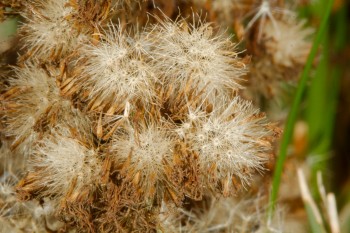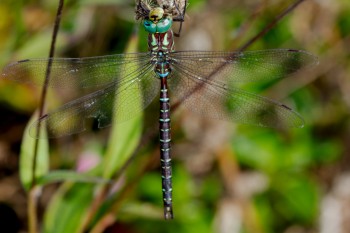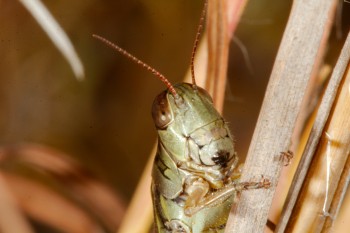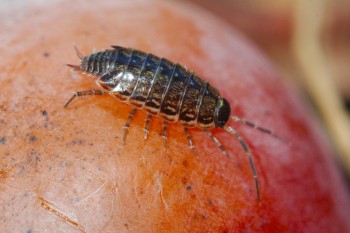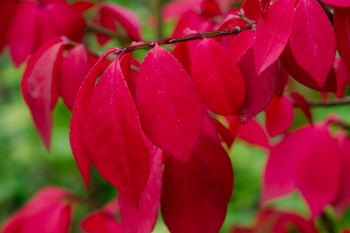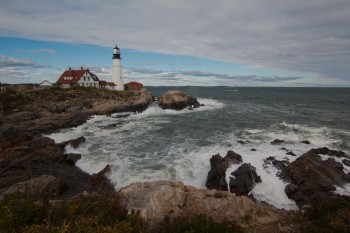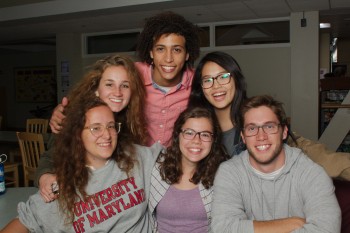I didn’t have a lot of time for photography today. I did manage to get out into the back yard for about ten minutes between work and somewhere I needed to be. I got some more good spider pictures but once again I’m going to hold back. It’s hard but I like to safe that for really good pictures, new spiders, or when I really have nothing else to show you. This is blue mistflower (Conoclinium coelestinum). It doesn’t look very blue, at this point, though. It has gone to seed, and close up, the seeds are pretty little helicopters the are actually all over our back yard now, especially in the spider webs that I’m not showing you today.
Monthly Archives: October 2015
Conoclinium coelestinum (Blue Mistflower)
Vulpes vulpes (Red Fox)
I happened to walk into the kitchen late this morning and look out the back door. Right in front of me, smack dab in the middle of the yard, was this young fox. I don’t know that it’s young, actually, but it was definitely smaller than the two we had in the yard February, March, and June of 2014. Mostly it was just sitting there scratching itself. Twice it stopped and looked right at me and both times I felt like it was saying, are you going to chase me off, or not? Both times it decided I was not and went back to scratching. Even in this picture, you can see its hind leg is slightly raised, about to start up again.
Aeshna umbrosa (Shadow Darner)
I had just returned from the grocery store and Cathy was in the front yard weeding. She called in to say that there was a largish dragonfly on the Queen Anne’s lace (Daucus carota) by the driveway. I grabbed my camera, slapped on the macro lens and was able to get a half dozen photographs before he flew away. This is a male shadow darner (Aeshna umbrosa), identified by my sister-in-law with that confirmed later by bugguide.net.
Charlotte and Cathy
It was nice to be at the WCA Banquet this evening. Without having a child at the school, it is all too easy to lose touch with people we really enjoy, so we were glad to take this opportunity to keep our friendships alive. One person we didn’t particularly expect to see what Charlotte. Her youngest is a senior and was going to a different school but transferred back to WCA, so she was at the banquet. As you can see, the photo of Charlotte and Cathy was fairly expertly photobombed by Charlotte’s husband, Andy.
Grasshopper, Family Acrididae
I went out into the empty lot next to my building today. It’s getting fairly deeply overgrown and it’s harder to make my way through it. I did find a few pathways, probably made by deer, and that helped a bit. I came across this little grasshopper and was able to get close enough for a few photographs. I cannot say more than that I believe it is in family Acrididae. That narrows it down to about 620 species in North America (and 8,000 worldwide) and I’m not even 100% sure of that. So, we’ll just call it a grasshopper, shall we?
Bombus impatiens (Common Eastern Bumblebee)
I took pictures today of a bumble bee, a carpenter bee, and a spider. I’ve posted pictures of all three this summer, so whatever I post, it’s going to be a repeat. While some like my spider pictures, they tend to be a little less popular for some reason, so I decided to go with the bumble bee. One of the characteristics that allows you to distinguish the bumble bee from the carpenter bee is the presence or absence of hairs on the abdomen. You can see them fairly clearly in this picture. A bald or nearly bald abdomen (the rear-most section of an insect—head, thorax, and abdomen) mean carpenter bee. Harry means bumble bee. They are actually quite different in terms of their eyes, as well, and the male carpenter bee has a big white patch on his face.
Philoscia muscorum (Common Striped Woodlouse)
As a kid we knew anything that looked at all like one of these as roly-poly bugs or potato bugs. The more proper roly-poly, the pillbugs in family Armadillidiidae, are also known colloquially as armadillo bugs. They are mostly not native to North America but are fairly common, now. This is a common striped woodlouse, Philoscia muscorum, a genus and species also introduced from Europe. I was actually on the ground photographing a persimmon (Diospyros virginiana) that had fallen from a tree, when this little fellow started crawling up onto the fruit. Compared to other woodlice, this is a speedy little thing and I kept having to turn him around so he wouldn’t get away. I didn’t bother him for long, though, and he went on his merry way.
Burning Bush (a.k.a. Winged Euonymus)
Because of the semi-drought we had over the latter part of the summer, the fall colors may not be as spectacular this year as in some years. There will be exceptions, of course. Some plants can be counted on to provide good color in almost any conditions. In this case, the drought had less effect that it might have done because this is growing in a pot at the top of our driveway and was watered somewhat regularly. The winged euonymus (Euonymus alatus, also known as burning bush), is one of the more reliable plant for fall color. It is considered an invasive weed and its use is discouraged in many and even banned in some jurisdictions.
Rockland Bakery
We’ve made the trip to north of Boston twice now. That means four chances to stop at Rockland Bakery in Nanuet, New York. We have taken advantage of that opportunity all four times. It is becoming ‘a thing.’ I posted a picture from our second visit, on the way home from our first time up to school (Sunday, August 23, 2015). If you happen to be heading to or from New England and crossing the Hudson on the Tappan Zee Bridge, the bakery isn’t going to be very far out of your way. It’s worth it for the smell, alone. They, if you buy nothing else, pick up a hot bagel off the conveyor and buy some cream cheese butter to go with it. You won’t regret it, I promise (unless you have celiac disease, I suppose, in which case, maybe not).
Portland Head Light
Earlier in the week, the forecast had been for Hurricane Joaquin to have made landfall and be dumping huge amounts of rain all up the eastern seaboard. As it turned out, the European Center for Medium range Weather Forecasting (ECMWF) forecast model had the best track and the storm moved north well out to sea. We had a beautiful, if somewhat breeze and mostly cloudy day. We drove up to Portland, Maine with Dorothy and two of her friends. After wandering around in downtown Portland and stopping for donuts (at The Holy Donut) and lunch (Andy’s Old Port Pub), we went to Fort Williams Park and Portland Head Light.
Dorothy and Some Friends
We weren’t going to spend a week visiting Dorothy at school and not meet some of her friends. That’s mostly what we did today, hanging out at our hotel and doing a little shopping until the later afternoon. Then we met various groups of Dorothy’s friends. This is one of a few group pictures that I took the help me remember names and put them to faces as Dorothy talks about people she is hanging out or doing things with over the course of the semester. I didn’t get pictures of everyone she talks about, but what I have will be a big help to me. I’m hopeless when it comes to names.
Wingaersheek Beach
Dorothy only has one class on Thursdays and it isn’t until the middle of the afternoon. So, we had an outing together this morning. We picked her up from school and drove up to Wingaersheek Beach on the west side of the Annisquam River inlet. It was very windy today, more so even than yesterday, and cool, probably somewhere in the mid 50s. But beautiful for all of that.
We walked out on the sand and around the rocks on the north end of the beach. The tide was pretty far out but had turned and was coming in. From there we drove to Essex and had lunch at Woodman’s, a “quintessential New England clam shack is where, in 1916, ‘Chubby’ Woodman invented the fried clam.”

